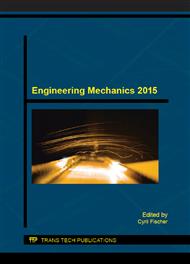[1]
S. Hu, F. Liu, Y. He, and T. Hu, An on-line approach for energy efficiency monitoring of machine tools, J. Clean. Prod., vol. 27, p.133–140, (2012).
DOI: 10.1016/j.jclepro.2012.01.013
Google Scholar
[2]
T. Behrendt, A. Zein, and S. Min, Development of an energy consumption monitoring procedure for machine tools, CIRP Ann. - Manuf. Technol., vol. 61, p.43–46, (2012).
DOI: 10.1016/j.cirp.2012.03.103
Google Scholar
[3]
A. Vijayaraghavan and D. Dornfeld, Automated energy monitoring of machine tools, CIRP Ann. - Manuf. Technol., vol. 59, no. 1, p.21–24, (2010).
DOI: 10.1016/j.cirp.2010.03.042
Google Scholar
[4]
R. Huzlík, P. Blecha, A. Vašíček, P. Houška, and M. Holub, Device for Measuring of Active Power and Energy at Machine Tools, in Mechatronics 2013, 2013, p. p.503–509.
DOI: 10.1007/978-3-319-02294-9_64
Google Scholar
[5]
J. Böhner, M. Hamacher, A. Reger, and R. Steinhilper, Derivation of measures for energy efficient machine design by evaluating energy consumption data, Procedia CIRP, vol. 15, p.437–442, (2014).
DOI: 10.1016/j.procir.2014.06.062
Google Scholar
[6]
R. Huzlík, M. Holub, F. Bradáč and P. Blecha, SIMULATION OF LINEAR AXIS WITHBALL SCREW AND PERMANENT MAGNET SYNCHRONOUS MACHINE. (2012).
Google Scholar
[7]
M. -F. Hsieh, H. -Y. Li, and K. -Y. Lai, Synchronous control of a network-based triple mechanically-coupled ball screws system, SICE Annu. Conf. 2011, no. dll, p.1081–1086, (2011).
Google Scholar
[8]
I. X. Bogiatzidis, A. N. Safacas, E. D. Mitronikas, and G. a. Christopoulos, A novel control strategy applicable for a dual AC drive with common mechanical load, IEEE Trans. Ind. Appl., vol. 48, no. 6, p.2022–2036, (2012).
DOI: 10.1109/tia.2012.2226196
Google Scholar
[9]
C. S. Teo, K. K. Tan, S. Y. Lim, S. Huang, and E. B. Tay, Dynamic modeling and adaptive control of a H-type gantry stage, Mechatronics, vol. 17, no. April, p.361–367, (2007).
DOI: 10.1016/j.mechatronics.2007.04.004
Google Scholar
[10]
T. Wang, W. Zhou, S. Zhao, and W. Yu, Robust master-slave synchronization for general uncertain delayed dynamical model based on adaptive control scheme, ISA Trans., vol. 53, no. 2, p.335–340, (2014).
DOI: 10.1016/j.isatra.2013.11.009
Google Scholar
[11]
Z. X. Z. Ximei and G. Q. G. Qingding, H_ Robust Control for Dual Linear Motors Servo System, 2006 CES/IEEE 5th Int. Power Electron. Motion Control Conf., vol. 3, p.6–8, (2006).
DOI: 10.1109/ipemc.2006.4778320
Google Scholar
[12]
M. F. Hsieh, W. S. Yao, and C. R. Chiang, Modeling and synchronous control of a single-axis stage driven by dual mechanically-coupled parallel ball screws, Int. J. Adv. Manuf. Technol., vol. 34, p.933–943, (2007).
DOI: 10.1007/s00170-007-1135-4
Google Scholar
[13]
M. -F. Hsieh, C. -J. Tung, W. -S. Yao, M. -C. Wu, and Y. -S. Liao, Servo design of a vertical axis drive using dual linear motors for high speed electric discharge machining, Int. J. Mach. Tools Manuf., vol. 47, no. 3–4, p.546–554, Mar. (2007).
DOI: 10.1016/j.ijmachtools.2006.05.011
Google Scholar


